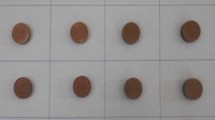Abstract
Wear on the tool electrode is one of the most critical issues in electro discharge machining (EDM) process, as it affects the dimensional accuracy of the final feature as well as increase in total production cost due to the requirement of post processing. In present study, an attempt has been made to develop a compensation model for end wear of the tool electrode during planetary EDM of Ti–6Al–4V using adaptive neuro fuzzy inference system (ANFIS). Prior to model development, detailed analysis has been carried out to understand the effect of various electrical as well as tool actuation parameters on end wear of the tool electrode. Further, an algorithm is coded in MATLAB interface using the ANFIS model developed for end wear as the prediction element. The proposed model is capable of providing the compensated machining depth for a specified cavity dimension when a set of electrical and tool actuation parameters are provided. Validation of the model has been carried out by comparing the predicted and actual results for machining depth under different experimental conditions. The values of compensated depth obtained using the proposed model are found to be in reasonable agreement with actual results.








Similar content being viewed by others
References
Singh A, Kumar P, Singh I (2013) Electric discharge drilling of metal matrix composites with different tool geometries. Proc Inst Mech Eng Part B J Eng Manuf 227(8):1245–1249
Jahan MP, Rahman M, Wong S et al (2010) On-machine fabrication of high-aspect-ration micro-electrode and application in vibration-assisted micro-electrodischarge drilling of tungsten carbide. Proc Inst Mech Eng Part B: J Eng Manuf 224(5):765–814
Rajurkar KP, Royo GF (1989) Effect of RF control and orbital motion on surface integrity of EDM components. J Mech Work Technol 20:341–352
Yu ZY, Rajurkar KP, Shen H (2002) High aspect ratio and complex shaped blind micro holed by micro EDM, CIRP Ann. Manuf Technol 51(1):359–362
El-Taweel TA, Hewidy MS (2009) Enhancing the performance of electrical-discharge machining via various planetary modes. Int J Mach Machinabil Mater 5(2–3):308–320
Bamberg E, Heamawatanachai S (2009) Orbital electrode actuation to improve efficiency of drilling micro holes by micro-EDM. J Mater Process Technol 209:1826–1834
Kaneko T, Tsuchiya M (1988) Three-dimensional numerically controlled contouring by electric discharge machining with compensation for the deformation of cylindrical tool electrodes. Precis Eng 10(3):157–163
Yan MT, Lin SS (2011) Process planning and electrode wear compensation for 3D micro-EDM. Int J Adv Manuf Technol 53:209–219
Bissacco G, Tristo G, Valentincic J (2010) Assessment of electrode wear measurement in micro EDM milling. In: Proceedings of 6th international conference on multi material micro manufacture (4M), pp. 155–158
Yu ZY, Masuzawa T, Fujino M (1998) Micro-EDM for three-dimensional cavities-development of uniform wear method. CIRP Ann Manuf Technol 47(1):169–172
Bleys P, Kruth JP, Lauwers B (2004) Sensing and compensation of tool wear in milling EDM. J Mater Process Technol 149:139–146
Li L, Hao J, Deng Y et al (2013) Study of dry EDM milling integrated with electrode wear compensation and finishing. Mater Manuf Process 28:403–407
Tong H, Zhang L, Li Y (2014) Algorithms and machining experiments to reduce depth errors in servo scanning 3D micro EDM. Precis Eng 38:538–547
Yu HL, Luan JJ, Li JZ et al (2010) A new electrode wear compensation method for improving performance in 3D micro EDM milling. J Micromec Microeng 20:1–7
Chang YF, Chiu ZH (2004) Electrode wear-compensation of electric discharge scanning process using a robust gap-control. Mechatron 14:1121–1139
Bissacco G, Tristo G, Hansen HN et al (2013) Reliability of electrode wear compensation based on material removal per discharge in micro EDM milling. CIRP Ann Manuf Technol 623:179–182
Teimouri R, Sohrabpoor H (2013) Application of adaptive neuro-fuzzy inference system and cuckoo optimization algorithm for analysing electrochemical machining process. Front Mech Eng 8(4):429–442
Caydas U, Hascalik A, Ekici S (2009) An adaptive neuro-fuzzy inference system (ANFIS) model for wire-EDM. Expert Syst with Appl 36:6135–6139
Maji K, Pratihar DK (2010) Forward and reverse mappings of electrical discharge machining process using adaptive network-based fuzzy inference system. Expert Syst Appl 37:8566–8574
Suganthi XH, Natarajan U, Sathiyamurthy S et al (2013) Prediction of quality responses in micro-EDM process using adaptive neuro-fuzzy inference system (ANFIS) model. Int J Adv Manuf Technol 68(1):339–347
Al-Ghamdi K, Taylan O (2015) A comparative study on modelling material removal rate by ANFIS and polynomial methods in electrical discharge machining process. Computers Ind Eng 79:27–41
Shabgard MR, Badamchizadeh MA, Ranjbary G et al (2013) Fuzzy approach to select machining parameters in electrical discharge machining (EDM) and ultrasonic-assisted EDM process. J Manuf Syst 32:32–39
Azhiri RB, Teimouri R, Baboly MG et al (2014) Application of Taguchi, ANFIS and grey relational analysis for studying, modelling and optimization of wire EDM process while using gaseous media. Int J Adv Manuf Technol 71:279–295
Mathai VJ, Dave HK, Desai KP (2016) Experimental investigations on EDM of Ti6Al4V with planetary tool actuation. J Braz Soc Mech Sci Eng. https://doi.org/10.1007/s40430-016-0657-9
Jang JS (1993) ANFIS: adaptive-network-based fuzzy inference system. Syst Man Cybern IEEE Trans 23(3):665–685
Jang JS. Sun CT, Mizutani E (1997) Neuro-fuzzy and soft computing—a computational-approach to learning and machine intelligence. Prentice-Hall, Upper Saddle River, NJ
Wei M, Bai B, Sung AH et al (2007) Predicting injection profiles using ANFIS. Inf Sci 177(20):4445–4461
Dave HK, Desai KP, Raval HK (2013) Development of semi empirical model for predicting material removal rate during orbital electro discharge machining of Inconel 718. Int J Mach Mach Mater 13(2–3):215–230
Acknowledgements
This work is supported by Gujarat Council of Science and Technology (GUJCOST), Government of Gujarat, India [Grant permission number: GUJCOST/MRP/2014-15/402]. Further, the assistance provided by Mr. Parth U. Rana, Department of Mechanical Engineering, S. V. National Institute of Technology, Surat, Gujarat, for MATLAB coding is also deeply acknowledged.
Author information
Authors and Affiliations
Corresponding author
Rights and permissions
About this article
Cite this article
Mathai, V.J., Dave, H.K. & Desai, K.P. End wear compensation during planetary EDM of Ti–6Al–4V by adaptive neuro fuzzy inference system. Prod. Eng. Res. Devel. 12, 1–10 (2018). https://doi.org/10.1007/s11740-017-0778-8
Received:
Accepted:
Published:
Issue Date:
DOI: https://doi.org/10.1007/s11740-017-0778-8




